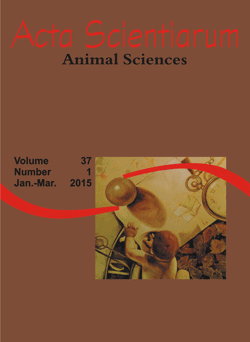<b>Performance, carcass characteristics and litter moisture in broilers housed at two densities
Abstract
The effect of stocking density in broiler chickens (11.08 and 13.20 birds m-2), between 5 and 45 days of age, was assessed with regard to performance, cut yield, litter moisture and frequency of pododermatitis injuries. Further, 476 one-day chicks Cobb 500® were distributed in a completely randomized design at two densities (birds m-²), with seven replications per treatment in 14 experimental units. Birds housed at a lower density (11.08) increased feed intake (p < 0.05), without any effect on weight gain and feed conversion. Retail yields were not influenced (p > 0.05) by treatments. In the case of higher density (3.20)the litter showed higher moisture content (p < 0.05) at 28 and 35 days of age. There was a higher occurrence of pododermatitis in birds housed at a density of 13.20 birds m-2. Results show that increased housing density from 11.08 to 13.20 birds m-2 does not affect growth performance, carcass yield and cuts. However, a housing density of 13.20 birds m-2 increased litter moisture and provided a higher occurrence of grade I pododermatitis.
Downloads
DECLARATION OF ORIGINALITY AND COPYRIGHTS
- I Declare that current article is original and has not been submitted for publication, in part or in whole, to any other national or international journal.
The copyrights belong exclusively to the authors. Published content is licensed under Creative Commons Attribution 4.0 (CC BY 4.0) guidelines, which allows sharing (copy and distribution of the material in any medium or format) and adaptation (remix, transform, and build upon the material) for any purpose, even commercially, under the terms of attribution.
Read this link for further information on how to use CC BY 4.0 properly.








































